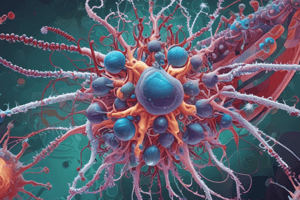Podcast
Questions and Answers
What is the characteristic arrangement of capsomeres in a 2-helical structure?
What is the characteristic arrangement of capsomeres in a 2-helical structure?
- A hollow sphere
- A hollow coil that appears rod-shaped (correct)
- A spiral pattern
- A cubic arrangement
Which type of capsomere arrangement is described as neither cubic nor helical?
Which type of capsomere arrangement is described as neither cubic nor helical?
- Complex (correct)
- 2-helical
- Cubic
- Helical
What is the shape of a 2-helical capsomere arrangement?
What is the shape of a 2-helical capsomere arrangement?
- Oval
- Cubic
- Rod-shaped (correct)
- Spherical
What do capsomeres structurally represent in a capsid?
What do capsomeres structurally represent in a capsid?
Which of the following is NOT a characteristic of a 2-helical capsomere arrangement?
Which of the following is NOT a characteristic of a 2-helical capsomere arrangement?
What is the function of capsomeres in the viral structure?
What is the function of capsomeres in the viral structure?
What term is used to describe a capsomere arrangement that is neither helical nor cubic?
What term is used to describe a capsomere arrangement that is neither helical nor cubic?
What is the relationship between capsomeres and polypeptides?
What is the relationship between capsomeres and polypeptides?
What do capsomeres morphologically represent?
What do capsomeres morphologically represent?
What is the role of capsomeres in the viral capsid?
What is the role of capsomeres in the viral capsid?
Which of the following viruses has an icosahedral head and a helical tail?
Which of the following viruses has an icosahedral head and a helical tail?
Which virus has a envelope with spikes?
Which virus has a envelope with spikes?
Which of the following viruses does not have an envelope?
Which of the following viruses does not have an envelope?
What is the shape of the head of the bacteriophage?
What is the shape of the head of the bacteriophage?
Which of the following viruses is not icosahedral in shape?
Which of the following viruses is not icosahedral in shape?
What is a critical factor in determining the stability of a viral protein?
What is a critical factor in determining the stability of a viral protein?
Which of the following is a key factor in the susceptibility of a viral protein to chemicals such as ether?
Which of the following is a key factor in the susceptibility of a viral protein to chemicals such as ether?
What is the primary determinant of a viral protein's antigenic properties?
What is the primary determinant of a viral protein's antigenic properties?
Which of the following factors can affect the stability of a viral protein?
Which of the following factors can affect the stability of a viral protein?
What is a critical factor in the characterization of a viral protein?
What is a critical factor in the characterization of a viral protein?
What is an important characteristic of a virus's capsid used in classification?
What is an important characteristic of a virus's capsid used in classification?
Which of the following is not a characteristic used to classify viruses?
Which of the following is not a characteristic used to classify viruses?
What is the main purpose of classifying viruses?
What is the main purpose of classifying viruses?
Which of the following viral components is NOT used in classification?
Which of the following viral components is NOT used in classification?
Why is classification of viruses important?
Why is classification of viruses important?
Flashcards are hidden until you start studying
Study Notes
Viral Structure: Capsomeres and Capsid
- Capsomeres are the morphological units that form the capsid, composed of clusters of polypeptides.
- Capsomeres can be arranged in different ways, leading to distinct viral structures.
Capsid Arrangement
- 2-Helical capsid: capsomeres are arranged in a hollow coil that appears rod-shaped.
- 3-Complex capsid: capsomeres are arranged in a more complex structure that is neither cubic nor helical.
Viral Shapes and Components
- Icosahedral shape: found in viruses such as bacteriophages, herpes simplex virus, polio virus, and HIV.
- Helical shape: found in the tails of some viruses, such as bacteriophages.
- Enveloped viruses: have a lipid bilayer that surrounds the capsid, found in viruses such as herpes simplex virus and HIV.
- Unenveloped viruses: do not have a lipid bilayer, found in viruses such as polio virus.
- Spikes on envelope: found in viruses such as HIV.
Viral Classification
- Capsid characteristics: symmetry, size, and whether it is enveloped or not, are used in virus classification.
- Other viral components used in classification include:
- Molecular mass
- pH stability
- Thermal stability
- Susceptibility to chemicals
- Antigenic properties
Studying That Suits You
Use AI to generate personalized quizzes and flashcards to suit your learning preferences.

